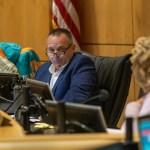In the last couple years I’ve seriously upped my daily exercise game. Until about six weeks ago I spent about an hour on an elliptical machine almost every day. An elliptical was key because a few years ago I tore my ACL and in consultation with my doctor decided not to have it repaired. It didn’t hurt and I had basically full function. Jogging as a regular exercise was out. But I never liked jogging anyway. But without access to a gym that became more of an issue. Don’t get me wrong. I can run and even sprint. But I can feel in my knee that an hour of it a day over time is not a good idea. So I’ve resorted to long walks which meant I needed something to listen to.
That led me to the back catalog of our house podcast. It’s pretty good! If you haven’t checked it out definitely give it a listen. For me though it has been fascinating to retrace the last eight weeks in reverse: the slow machinery of impending crisis half a world away accelerating into a full national emergency and perhaps the greatest public crisis of our lifetimes.
The modern craft of history writing is so essential because it forces us constantly to peel back the stories we tell ourselves about the past. This is a complicated process because the meaning of the past – to the extent such a thing exists – only becomes clear in the light of the present or subsequent events. Our brains are hardwired for narrative. We can only truly understand things when they are pieced together as events unfolding in time, with meaning, focus and action. We are a storytelling species. This means it’s never so simple as false or distorted ‘history’ and the real events. But to remain grounded we must constantly be interrogating our individual memory and the collective memory of history with the unvarnished rudiments of the past: the raw materials and artifacts of earliest events before they were organized into coherence.
Our podcast is basically a group discussion of the news of the day and what we at TPM are covering. So listening to them in reverse chronological order has given me this uncanny experience of traveling back in time, not just dropping in on one moment but seeing how it all unfolded by going back and seeing it refolded again. It’s like Groundhog Day but each day one day earlier than the day before.
One reason it is so striking – as I’m sure many of you have experienced – is that things that happened only six or seven weeks ago seem like a lifetime ago. Each week back is a significantly different world. Yesterday I listened our March 4th episode. This was coming off Super Tuesday. Matt Shuham was filling in for Kate Riga, who was getting settled into Washington, DC after her move from New York. Super Tuesday, which was the night before, was still a key focus but Coronavirus was already a big part of the discussion. I remembered all of this hazily. But so much has been layered on since that I was reminded of one of the most uncanny, surreal parts of those few days in late February and early March.
In these critical days there was still very little clear messaging from the federal government. Indeed, there wasn’t a lot from any level of government. There were press conferences here and there but the general message was still the risk is low; go about your normal activities; no need for panic. But while this was happening numerous TPM Readers around the country were hearing from employers – often large national or international corporations – moving employees to remote work, canceling international travel, then domestic travel, then ordering employees on remote locations to return to their home bases immediately. Meanwhile we were hearing from TPM Readers and TPM Reader clinicians from in and around Kirkland, Washington. What was happening? Were there five cases or 500 or 5,000? They were being told to limit contact with other people but go about their normal activities – two directives that weren’t easy to reconcile.
In different ways both streams of information told a similar story. The national message was still basically everything is okay. But more than everything is okay it was mostly silence – especially at the federal level but to a degree at all levels, no doubt because with a novel disease from abroad about which little was known local governments weren’t in much position to know what to tell people. Our email channel from readers gave us a unique view into this. At the surface level, national life was still close to business as usual. But just under the surface, the private economy was already starting to shut down. Lots of people knew their company was already ramping down. It was hard to know half the other companies across the country were doing the same. Even the press had a hard time fully getting its collective hands around the story because no individual company had much interest in telling it. The big moves were in international commerce and travel and in the tech sector which is anchored on the west coast and deeply tied into the Pacific Rim economy. But the private sector seemed to know what was happening and be making it happen before the federal government fully awoke to the reality.
I remembered this liminal moment. But it had been buried over by all the subsequent events: the controversies over testing, ventilators, lockdown orders, the President’s early February travel ban and so much else. But here at the outset of the US part of the crisis in late February was the now-familiar pattern: a distracted federal government, disorganized in its response, dominated by the personal drama of the chief executive and generally absent while the society itself was moving half organically in the absence of any guidance from above. Beneath the storm and gravitation of the President’s predatory personality the story, the pattern has been consistent throughout.







